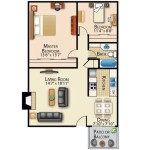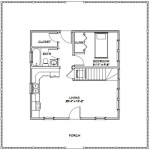Designing your own house floor plan entails the detailed layout of the rooms, spaces, and structural elements of a residential building. It serves as a blueprint for the construction and organization of your future home, ensuring that it aligns with your specific requirements and preferences.
For instance, consider a couple planning to build their dream home. They desire an open-concept floor plan that seamlessly connects the living room, dining area, and kitchen, fostering a sense of spaciousness and facilitating easy flow between these key living areas.
Creating a floor plan involves careful consideration of various factors, including the number of rooms required, their intended purposes, the optimal placement of windows and doors for natural lighting and ventilation, and the efficient utilization of space to maximize both functionality and aesthetic appeal. The subsequent sections of this article will delve into the essential elements, principles, and tools involved in designing your own house floor plan, empowering you to create a home that truly reflects your unique lifestyle and aspirations.
When designing your own house floor plan, there are several important considerations to keep in mind:
- Consider your needs: How many rooms do you need? What are their intended purposes?
- Think about flow: How do you want to move through your home? Where should the main entryways be?
- Maximize natural light: Place windows and doors strategically to let in plenty of sunlight.
- Plan for storage: Include closets, cabinets, and other storage solutions throughout your home.
- Choose the right materials: Consider the durability, cost, and aesthetic appeal of different flooring, wall, and countertop materials.
- Pay attention to details: Don’t forget about small details like doorknobs, light fixtures, and moldings.
- Consider your budget: Make sure your floor plan is realistic given your financial constraints.
- Get feedback from others: Share your floor plan with friends, family, or a professional to get their input.
- Be prepared to make changes: Your floor plan may evolve as you gather more information and feedback.
By following these tips, you can create a house floor plan that meets your specific needs and creates a home that you love.
Consider your needs: How many rooms do you need? What are their intended purposes?
The first step in designing your own house floor plan is to consider your needs. How many rooms do you need? What are their intended purposes? This will help you determine the overall size and layout of your home.
Here are some things to consider when determining your needs:
- Number of people: How many people will be living in the home?
- Lifestyle: What are your daily routines and activities? How do you use your current home?
- Future plans: Do you plan to have children or expand your family in the future? Do you have any hobbies or interests that require dedicated space?
- Budget: How much can you afford to spend on your new home?
Once you have a good understanding of your needs, you can start to think about the specific rooms you need and their intended purposes. Here are some common rooms to consider:
- Bedrooms: How many bedrooms do you need? What size should they be?
- Bathrooms: How many bathrooms do you need? What fixtures and features do you want in each bathroom?
- Kitchen: What type of kitchen do you want? How much counter and storage space do you need?
- Living room: How do you want to use your living room? Do you need a formal living room or a more casual family room?
- Dining room: Do you need a separate dining room? How many people should it accommodate?
- Other rooms: Do you need any other rooms, such as a home office, playroom, or guest room?
Once you have a list of the rooms you need, you can start to think about their layout. How do you want the rooms to flow together? What kind of traffic patterns do you anticipate? It is also important to consider the placement of windows and doors to maximize natural light and ventilation.
By carefully considering your needs, you can create a house floor plan that meets your specific requirements and creates a home that you love.
Think about flow: How do you want to move through your home? Where should the main entryways be?
Once you have determined the rooms you need and their intended purposes, the next step is to think about how you want to move through your home. This is known as flow. Good flow means that the rooms are arranged in a logical and efficient way, and that there is a natural progression from one space to the next.
Here are some things to consider when thinking about flow:
- Main entryways: Where should the main entryways to your home be located? You want to choose a location that is convenient and accessible, but also one that is not too close to private areas of your home.
- Traffic patterns: How do you anticipate people moving through your home? Do you want to create a circular flow, where people can easily move from one room to the next without having to backtrack? Or do you want to create a more linear flow, where people move from one end of the house to the other?
- Adjacency: Which rooms should be adjacent to each other? For example, it makes sense to have the kitchen adjacent to the dining room, and the master bedroom adjacent to the master bathroom.
- Privacy: Which rooms need to be more private than others? For example, you may want to place the bedrooms in a more private area of the home, away from the main living areas.
By carefully considering flow, you can create a house floor plan that is both functional and inviting. Here are some tips for creating good flow in your home:
- Use open floor plans: Open floor plans can help to create a more spacious and inviting atmosphere, and they can also improve flow by eliminating walls and other barriers.
- Create clear pathways: Make sure that there are clear pathways between all of the rooms in your home. Avoid creating narrow hallways or doorways that can impede flow.
- Use furniture to define spaces: You can use furniture to define different spaces within a room, and to create a more intimate and inviting atmosphere.
- Pay attention to lighting: Good lighting can help to improve flow by making it easier to see and move around.
By following these tips, you can create a house floor plan that has good flow and that meets your specific needs.
Maximize natural light: Place windows and doors strategically to let in plenty of sunlight.
Natural light can make your home feel more spacious, inviting, and cheerful. It can also help to reduce your energy costs by reducing the need for artificial lighting. When designing your house floor plan, be sure to place windows and doors strategically to let in as much natural light as possible.
- South-facing windows: South-facing windows are the best for letting in natural light. This is because the sun is highest in the sky during the middle of the day, when the sun is shining directly through south-facing windows.
- Large windows: Large windows let in more light than small windows. If you want to maximize the amount of natural light in your home, choose large windows whenever possible.
- Windows in every room: Every room in your home should have at least one window. This will help to ensure that all of your rooms are bright and airy.
- Skylights: Skylights are a great way to let in natural light from above. They are especially effective in rooms that don’t have a lot of windows, such as bathrooms and closets.
By following these tips, you can create a house floor plan that is filled with natural light. This will make your home more comfortable, inviting, and energy-efficient.
Plan for storage: Include closets, cabinets, and other storage solutions throughout your home.
Storage is an essential part of any home. It helps to keep your belongings organized and out of sight, and it can also help to make your home feel more spacious and inviting. When designing your house floor plan, be sure to include plenty of storage solutions throughout your home.
Here are some things to consider when planning for storage:
- Closets: Closets are a great way to store clothes, shoes, and other belongings. Be sure to include closets in all of the bedrooms, as well as in other areas of your home, such as the entryway, laundry room, and garage.
- Cabinets: Cabinets are another great way to store belongings. They can be used in the kitchen, bathroom, laundry room, and other areas of your home. Cabinets can be used to store a variety of items, such as dishes, cookware, cleaning supplies, and toiletries.
- Other storage solutions: In addition to closets and cabinets, there are a variety of other storage solutions that you can use in your home. These include shelves, drawers, baskets, and bins. You can use these solutions to store a variety of items, such as books, magazines, toys, and seasonal decorations.
When planning for storage, it is important to think about both your current needs and your future needs. For example, if you have a lot of clothes, you will need to include plenty of closet space. If you have a lot of books, you will need to include plenty of shelves. It is also important to think about the types of storage solutions that you want. For example, do you want open shelves or closed cabinets? Do you want drawers or baskets? By carefully planning for storage, you can create a home that is both functional and stylish.
Here are some additional tips for planning for storage:
- Use vertical space: Vertical space is often overlooked when it comes to storage. However, it can be a great way to maximize storage space. For example, you can use shelves to store items up high, or you can use hanging baskets to store items under shelves.
- Use multi-purpose furniture: Multi-purpose furniture is a great way to save space and add storage to your home. For example, you can use a coffee table with built-in storage, or you can use a bed with drawers.
- Declutter regularly: One of the best ways to keep your home organized is to declutter regularly. Get rid of anything that you don’t use or need. This will help to free up storage space and make your home feel more spacious.
By following these tips, you can create a house floor plan that includes plenty of storage solutions. This will help to keep your home organized and clutter-free, and it will also make your home feel more spacious and inviting.
Choose the right materials: Consider the durability, cost, and aesthetic appeal of different flooring, wall, and countertop materials.
When choosing the materials for your home, it is important to consider durability, cost, and aesthetic appeal. You want to choose materials that will last for many years, that fit your budget, and that you love the look of.
- Flooring: Flooring is one of the most important materials in your home. It needs to be durable enough to withstand foot traffic, spills, and other wear and tear. It also needs to be comfortable to walk on and easy to clean. There are many different types of flooring materials to choose from, including hardwood, carpet, tile, and laminate. Each type of flooring has its own unique advantages and disadvantages, so it is important to do your research before making a decision.
- Walls: Walls are another important part of your home. They can be used to divide up space, create privacy, and add style to your home. There are many different types of wall materials to choose from, including drywall, plaster, wood paneling, and wallpaper. Each type of wall material has its own unique advantages and disadvantages, so it is important to do your research before making a decision.
- Countertops: Countertops are an important part of your kitchen and bathroom. They need to be durable enough to withstand everyday use, and they also need to be easy to clean. There are many different types of countertop materials to choose from, including granite, quartz, marble, and laminate. Each type of countertop material has its own unique advantages and disadvantages, so it is important to do your research before making a decision.
- Cost: The cost of materials is an important consideration when designing your home. Some materials are more expensive than others, so it is important to set a budget before you start shopping. Once you have a budget, you can start to narrow down your choices based on price.
Choosing the right materials for your home is an important decision. By considering durability, cost, and aesthetic appeal, you can choose materials that will last for many years, that fit your budget, and that you love the look of.
Pay attention to details: Don’t forget about small details like doorknobs, light fixtures, and moldings.
When designing your house floor plan, it is important to pay attention to the small details. These details can make a big difference in the overall look and feel of your home. For example, the type of doorknobs you choose can add a touch of elegance or a bit of whimsy to your home. The light fixtures you choose can create a warm and inviting atmosphere or a more modern and sleek look. And the moldings you choose can add a touch of sophistication or a bit of rustic charm to your home.
Doorknobs are often overlooked, but they can be a great way to add a personal touch to your home. There are many different styles of doorknobs to choose from, so you can find one that matches your taste and the overall style of your home. For example, if you have a traditional home, you might choose a doorknob with a classic design. If you have a more modern home, you might choose a doorknob with a more contemporary design. You can also find doorknobs that are made from a variety of materials, such as metal, wood, and glass. This allows you to choose a doorknob that matches the other hardware in your home, such as the hinges and handles.
Light fixtures are another important detail to consider when designing your house floor plan. The type of light fixtures you choose can have a big impact on the overall atmosphere of your home. For example, if you want to create a warm and inviting atmosphere, you might choose light fixtures with soft, diffused light. If you want to create a more modern and sleek look, you might choose light fixtures with brighter, more focused light. You can also find light fixtures that are made from a variety of materials, such as metal, glass, and wood. This allows you to choose light fixtures that match the other dcor in your home, such as the furniture and artwork.
Moldings are another detail that can add a touch of elegance or sophistication to your home. Moldings can be used to frame doorways and windows, or to create decorative accents on walls and ceilings. There are many different styles of moldings to choose from, so you can find one that matches the overall style of your home. For example, if you have a traditional home, you might choose moldings with a classic design. If you have a more modern home, you might choose moldings with a more contemporary design. You can also find moldings that are made from a variety of materials, such as wood, plaster, and polyurethane. This allows you to choose moldings that match the other materials in your home, such as the flooring and cabinetry.
By paying attention to the small details, you can create a house floor plan that is both beautiful and functional. These details can make a big difference in the overall look and feel of your home, so it is important to take the time to choose the right ones.
Consider your budget: Make sure your floor plan is realistic given your financial constraints.
One of the most important things to consider when designing your own house floor plan is your budget. It is important to create a floor plan that is realistic given your financial constraints. This means considering the cost of materials, labor, and permits. It is also important to factor in the cost of ongoing maintenance and upkeep.
- Determine your budget: The first step is to determine your budget. This includes figuring out how much you can afford to spend on your new home, as well as how much you can afford to spend on the design and construction process. It is important to be realistic about your budget and to stick to it as closely as possible.
- Choose affordable materials: There are many different types of building materials available, and some are more expensive than others. When choosing materials for your home, it is important to consider both the cost and the quality of the materials. You want to choose materials that are durable and will last for many years, but you also want to choose materials that are affordable.
- Get multiple bids: Once you have chosen a design for your home, it is important to get multiple bids from different contractors. This will help you to ensure that you are getting the best possible price for your project. Be sure to compare the bids carefully before making a decision.
- Be prepared to compromise: It is unlikely that you will be able to get everything you want in your new home, especially if you have a limited budget. Be prepared to compromise on some of your wants in order to stay within your budget.
By following these tips, you can create a house floor plan that is both beautiful and affordable. It is important to remember that your budget is one of the most important factors to consider when designing your home. By being realistic about your budget and by making smart choices, you can create a home that you love without breaking the bank.
Get feedback from others: Share your floor plan with friends, family, or a professional to get their input.
Once you have created a draft of your floor plan, it is a good idea to get feedback from others. This can help you to identify any potential problems with your design, and to get suggestions for improvements. There are many different people you can ask for feedback, including friends, family, and professionals.
Friends and family can provide valuable feedback on the overall layout of your home, as well as on the specific details of your floor plan. They can help you to identify any areas that are confusing or inefficient, and they can also suggest ways to improve the flow of your home. Friends and family can also provide feedback on the aesthetic appeal of your home. They can help you to choose the right colors, materials, and finishes for your home, and they can also help you to create a home that reflects your unique style.
Professionals can provide more technical feedback on your floor plan. They can help you to ensure that your floor plan meets all of the building codes and regulations in your area. They can also help you to choose the right materials and construction methods for your home. Professionals can also provide feedback on the energy efficiency of your home. They can help you to design a home that is energy-efficient and that will save you money on your energy bills.
It is important to be open to feedback from others, even if you don’t agree with everything they say. Feedback can help you to improve your floor plan and to create a home that you love. When getting feedback from others, be sure to ask specific questions about your floor plan. For example, you might ask:
- Do you think the layout of my home is efficient?
- Are there any areas that are confusing or difficult to navigate?
- Do you like the overall aesthetic appeal of my home?
- Are there any changes you would make to my floor plan?
By getting feedback from others, you can create a floor plan that is both beautiful and functional.
Feedback from others can be invaluable in helping you to create the best possible floor plan for your home. By sharing your floor plan with friends, family, and professionals, you can get a variety of perspectives on your design. This feedback can help you to identify any potential problems with your floor plan, and to get suggestions for improvements. By being open to feedback from others, you can create a floor plan that is both beautiful and functional.
Be prepared to make changes: Your floor plan may evolve as you gather more information and feedback.
Once you have gathered feedback from others and done some additional research, you may need to make changes to your floor plan. This is a normal part of the design process. Don’t be afraid to make changes, even if you have already started construction. It is better to make changes early on than to be unhappy with your home later on.
There are many reasons why you may need to make changes to your floor plan. For example, you may need to make changes to meet the requirements of your building permit. You may also need to make changes to accommodate your changing needs or budget. Whatever the reason, it is important to be prepared to make changes to your floor plan.
Here are some tips for making changes to your floor plan:
- Be flexible: Don’t be too attached to your original design. Be willing to make changes if necessary.
- Consider the feedback you have received: When making changes to your floor plan, be sure to consider the feedback you have received from others.
- Do your research: Before making any changes, be sure to do your research and understand the implications of the changes.
- Get professional help if needed: If you are not sure how to make a particular change, don’t hesitate to get professional help.
By following these tips, you can make changes to your floor plan with confidence. Remember, the goal is to create a home that you love, so don’t be afraid to make changes until you are happy with the design.
Making changes to your floor plan is a normal part of the design process. By being prepared to make changes, you can create a home that you love.










Related Posts








